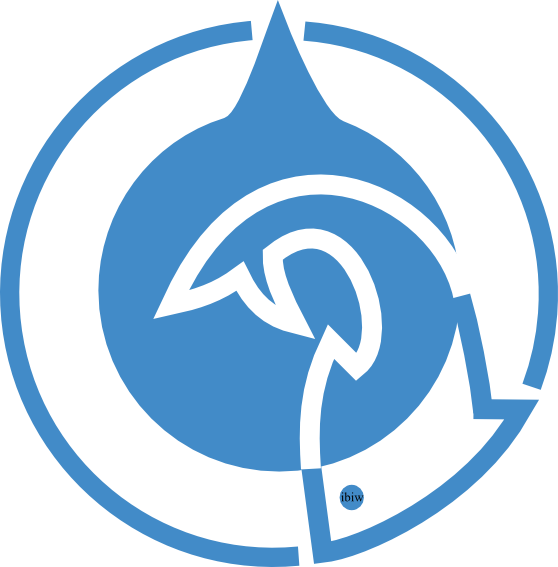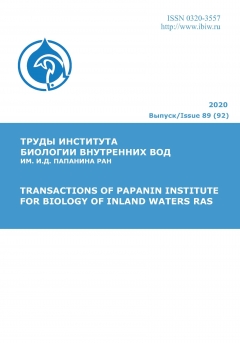Биохимические исследования двух видов хирономид показали, что в их гемолимфе содержатся различные формы гемоглобинов. Они обладают низкой молекулярной массой: мономеры — 15.9 кДа, и димеры — 31.4 кДа. В условиях диск-электрофореза выявлено до 12–16 различных фракций гемоглобинов. В гемолимфе Chironomus agilis (Shobanov, Djomin 1988) были обнаружены октамеры, пентамеры, тетрамеры, тримеры, димеры и мономеры, в состав которых входят субъединицы с молекулярной массой от 9.6 до 15.7 кДа. В гемолимфе Chironomus muratensis (Ryser, Scholl, Wülker 1983) были обнаружены октамеры, гексамеры, тетрамеры, тримеры, димеры и мономеры, состоящие из субъединиц с молекулярной массой от 11 до 15 кДа.
Chironomus agilis, muratensis, гемоглобин, Diptera, гемолимфа
1. Alyakrinskaya I.O. Physiological and biochemical adaptations to respiration of hemoglobin-containing hydrobionts. Biol. Bull., 2002, vol. 29. no. 3. pp. 268–283.
2. Alyakrinskaya O.I. Gemoglobiny i gemotsianiny bespozvonochnykh. (Biokhimicheskie adaptatsii k usloviyam sredy) [Hemoglobins and hemocianins of invertebrates. (Biological adaptations to environmental conditions)]. Moscow, Nauka, 1979. 155 p. (In Russian)
3. Andreeva A.M. Structural and functional organization of blood proteins and different extracellular fluids in fishes. Extended Abstract of Doc. Biol. Sci. Diss. Moscow, 2008. 41 p. (In Russian)
4. Aydemir H.B., Korkmaz E.M. Identification and characterization of globin gene from Bombus terrestris (Hymenoptera: Apocrita: Apidae). Biologia (Bratisl), 2023, vol. 78, no. 9, pp. 2517–2526. doi:https://doi.org/10.1007/s11756-023-01389-4.
5. Behlke J., Scheler W. The molecular properties of the methaemoglobin of Chironomus plumosus L. in Solution. Eur. J. Biochem., 1967, vol. 3, no. 2, pp. 153–157.
6. Bolshakov V.V., Prokin A.A., Pavlov D.D., Akkizov A., Movergoz E.A. Karyotypes and COI Gene Sequences of Chironomus sp. Le1 (Kiknadze and Salova, 1996), Ch. laetus (Belyanina and Filinkova, 1996) and Their Hybrid from the Yamal Peninsula, Arctic Zone of Russia. Insects, 2022, vol. 13, no.12, pp. 1112. doi:https://doi.org/10.3390/insects13121112.
7. Bolshakov V.V. The adaptive role of chromosomal rearrangements in larvae of the genus Chironomus (Diptera, Chironomidae). Extended Abstract of Cand. Biol. Sci. Diss. Borok, 2013. 24 p. (In Russian)
8. Bolshakov V.V., Fefilova E.B. Karyotype characteristics and the composition of hemoglobins in Chironomus sp. Ya3 (Diptera, Chironomidae) from the Pechora Delta. Entomol. Rev., 2020, vol. 100, no. 1, pp. 39–44. doi:https://doi.org/10.1134/S0013873820010017.
9. Bolshakov V.V., Andreeva A.M. Peculiarities of structural organization of hemoglobin of Chiromonus plumosus L. (Diptera: Chironomidae). J. Evol. Biochem. Physiol., 2012, vol. 48, no. 3, pp. 265–271. doi:https://doi.org/10.1134/S0022093012030024.
10. Braunitzer G. Die Polygenie der hamoglobine (erythrocruorine) der chironomiden. Limnologica, 1971, vol. 8, no. 1, pp. 119–127.
11. Creighton T.E. Electrophoretic analysis of the unfolding of proteins by urea. J. Mol. Biol., 1979, vol. 129, no. 2, pp. 235–264.
12. Creighton T.E. Kinetic study of protein unfolding and refolding using urea gradient electrophoresis. J. Mol. Biol., 1980, vol. 137, no. 1, pp. 61–80.
13. Dangott L.J. Structural and functional characterization of the extracellular hemoglobins of the branchiopod crustaceans Lepidurus bilobatus and Daphnia pulex. PhD dissertation, The University of Oregon, Biology dept., 1980, 178 p.
14. Das R., Handique R. Hemoglobin in Chironomus ramosus (Insecta, Diptera): an electrophoretic study of polymorphism, developmental sequence and interspecific relationship. Hydrobiologia, 1996, vol. 318, no. 1–3, pp. 43–50. doi:https://doi.org/10.1007/bf00014130.
15. English D.S. Ontogenetic changes in hemoglobin synthesis of two strains of Chironomus tentans. J. Embryol. Exp. Morphol., 1969, vol. 22, no. 3, pp. 465–76.
16. Golygina V.V, Kiknadze I.I., Istomina A.G. Cytogenetic divergence of genomes in Chironomus plumosus group (Diptera: Chironomidae). Comparative Cytogenetics, 2007, vol. 1, no. 1, pp. 17–32.
17. Hardison R.C. Hemoglobins from bacteria to man: evolution of different patterns of gene expression. J. Exp. Biol., 1998, vol. 201, no. 8, pp. 1099–1117.
18. Hardison R.C. A brief history of hemoglobins: plant, animal, protist, and bacteria. Proc. Natl. Acad. Sci., 1996, vol. 93, no. 12, pp. 5675–5679. doi:https://doi.org/10.1242/jeb.201.8.1099.
19. Herhold H.W., Davis S.R., Grimaldi D.A. Transcriptomes reveal expression of hemoglobins throughout insects and other Hexapoda. PLoS One, 2020, vol. 15, no. 6, p. e0234272. doi:https://doi.org/10.1371/journal.pone.0234272.
20. Keyl H.G. Chromosomenevolution bei Chironomus. II. Chromosomenumbauten und phylogenetische beziehungen der arten. Chromosoma, 1962, vol. 13, no. 1, pp. 464–514.
21. Kiknadze I.I., Istomina A.G., Golygina V.V., Gunderina L.I. Karyotypes of Palearctic and Holarctic species of the genus Chironomus [Electronic resource]. Novosibirsk, Academic Publishing House “GEO”, 2016. 489 p.
22. Korzhuev P. A. Sravnitel'naya fiziologiya i biokhimiya [Comparative Biochemistry and Physiology of Hemoglobins]. Moscow, Nauka, 1964. 284 p. (In Russian)
23. Korzhuev P.A., Nikolskaya I.S. Ob"em krovi nekotorykh morskikh i presnovodnykh ryb [The volume of blood of some marine and fresh water fish]. Dokl. Biol. Sci., 1951, vol. 80, no. 6, pp. 138–146. (In Russian)
24. Korzhuev P. A., Radzinskaya L.I. Kolichestvo gemoglobina v gemolimfe lichinok komara Chironomus plumosus [The quantity of hemoglobin in Chironomus plumosus larvae hemolymph]. Voprosy Ihtiologii, 1958, vol. 10, pp. 139–143. (In Russian)
25. Laemmli U.K. Cleavage of structural proteins during the assembly of the head of bacteriophage T4. Nature, 1970, vol. 227, no. 5259, pp. 680–685.
26. Lehninger A.L. Principles of biochemistry. New York, Worth Publishers, 1982. 1011 p.
27. Leitch I. The function of hemoglobin in invertebrates with special reference to Planorbis and Chironomus larvae. J. Physiol., 1916, vol. 50, no. 6, pp. 370–379.
28. Li S.Y., Zhao Y.M., Guo B.X., Li C.H., Sun B.J., Lin X.L. Comparative analysis of mitogenomes of Chironomus (Diptera: Chironomidae). Insects, 2022, vol. 13, no. 12, p. 1164.
29. Maurer H.R. Disc electrophoresis and related techniques of polyacrylamide gel electrophoresis. DE GRUYTER, 1978. 222 p.
30. Maximova F.L. K voprosu o kariotipe Chironomus plumosus L. ust'-izhorskoy populyatsii Leningradskoy oblasti [The karyotype of Chironomus plumosus from the Ust-Izhora wild population of Leningrad region]. Tsitologiia, 1976, vol. 18, no. 10, pp. 1264–1269. (In Russian)
31. Numoto N., Nakagawa T., Kita A., Sasayama Y., Fukumori Y., Miki K. Structure of an extracellular giant hemoglobin of the gutless beard worm Oligobrachia mashikoi. Proc. Natl. Acad. Sci., 2005, vol. 102, no. 41, pp. 14521–14526. doi:https://doi.org/10.1073/pnas.0501541102.
32. Osmulski P.A., Leyko W. Structure, function and physiological role of Chironomus haemoglobin. Comp. Biochem. Physiol., 1986, vol. 85, no. 4, pp. 701–722.
33. Prothmann A., Hoffmann F.G., Opazo J.C., Herbener P., Storz J.F., Burmester T., Hankeln T. The globin gene family in arthropods: evolution and functional diversity. Front. Genet, 2020, vol. 11, pp. 858. doi:https://doi.org/10.3389/fgene.2020.00858.
34. Schmidt-Nielsen K. Animal physiology: adaptation and environment. Cambridge University press, 1979. 560 p.
35. Shobanov N.A. The genus Chironomus Meigen (Diptera, Chironomidae) (Systematics, Biology, Evolution). Doc. Biol. Sci. Diss. Saint-Petersburg, 2000. 464 p. (In Russian)
36. Shobanov N.A. Heterogeneity and heterofunctionality of hemoglobins in bloodworms (Diptera, Chironomidae). J. Evol. Biochem. Physiol., 2004, vol. 40, no. 4, pp. 392–397. doi:https://doi.org/10.1023/B:JOEY.0000046535.66886.4d.
37. Shobanov N.A., Tayevskaya E.Y., Belkov V.M. Izmenenie sostava gemoglobinov motylya v ontogeneze [Changes of hemoglobins composition in the midge Chironomus riparius Meig. (Diptera, Chironomidae) during development]. Ontogenes, 1993, vol. 24, no. 2, pp. 43–48. (In Russian)
38. Thompson P., Bleecker W., English D.S. Molecular size and subunit of Chironomus tentans structure of the hemoglobins. J. Biol. Chem., 1968, vol. 243, no. 17, pp. 4463–4467.
39. Tichy H. Nature genetic basis and evolution of the haemoglobin polymorphism in Chironomus. J. Mol. Evol., 1975, vol. 6, no. 1, pp. 39–50.
40. Tichy H. Are the different Chironomus hemoglobins of monophyletic origin? Acta Univ. Carolinae-Biologica, 1978, vol. 12, pp. 253–257.
41. Tichy H., Kleinschmidt T., Braunitzer G. Studies on the evolutionary relationships between hemoglobins in Chironomus pallidivittatus and C. Tentans — I. Isolation and immunological analysis of monomeric and dimeric hemoglobins. J. Mol. Evol., 1981, vol. 18, no. 1, pp. 9–14.
42. Walshe B.M. Feeding Mechanisms of Chironomus Larvae. Nature, 1947, vol. 160, no. 4066, pp. 474–474.
43. Walshe B.M. The function of haemoglobin in Chironomus plumosus under natural conditions. J. Exp. Biol., 1950, vol. 27, no. 1, pp. 73–95.
44. Walshe B.M. The function of haemoglobin in relation to filter feeding in leaf-mining chironomid larvae. J. Exp. Biol., 1951, vol. 28, pp. 57–61.
45. Waxman L. The structure of annelid and mollusc hemoglobins. J. Biol. Chem., 1975, vol. 250, no. 10, pp. 3790–3795.
46. Weber R.E. Aspects of haemoglobin function in the larvae of the midge Chironomus plumosus L. Proc. K. ned. Acad. Wet., 1963, vol. 66, no. 3, pp. 284–295.
47. Weber R.E., Vinogradov S.N. Nonvertebrate hemoglobins: functions and molecular adaptations. Physiol. Rev., 2001, vol. 81, no. 2, pp. 569–628.
48. White A., Handler P., Smith E.L., Hill R.L., Lehman I.R. Principles of Biochemistry. New York, McGraw-Hill, 1978. vol. 6. 1492 p.








